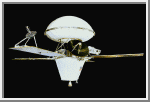![]()
 |
Viking Mission to Mars The Viking mission to Mars sent twin spacecraft to the Red Planet. This image shows a model of one of the Viking spacecraft, which were made of two parts: an orbiter and a lander. The orbiter's initial job was to survey the planet for a suitable landing site. Later the orbiter's instruments studied the planet and its atmosphere, while the orbiter acted as a radio relay station for transmitting lander data. Once on the surface of Mars, the lander surveyed the soil, wind, and atmosphere and conducted numerous experiments to determine the existence of past or present life. (Courtesy NASA/JPL |
| Home Michael Ammar Solar System Solar System Summary Sun Sun's Statistics Mercury Mercury's Statistics Venus Venus' Statistics Earth Earth's Statistics Mars Mars' Statistics Asteroid Field Asteroid Field's Statistics Jupiter Jupiter's Statistics Saturn Saturn's Statistics Uranus Uranus' Statistics Neptun Neptun's Statistics Pluto Pluto's Statistics Picture Library |
NASA's Viking Mission to Mars
was composed of two spacecraft, Viking 1 and Viking 2. Each spacecraft consisted of an
orbiter and a lander. The primary mission objectives were to
Viking 1 was launched on August 20, 1975 and arrived at Mars on June 19, 1976. The first month of orbit was devoted to imaging the surface to find appropriate landing sites for the Viking Landers. On July 20, 1976 Viking Lander 1 separated from the Orbiter and touched down at Chryse Planitia. Viking 2 was launched September 9, 1975 and entered Mars orbit on August 7, 1976. Viking Lander 2 touched down at Utopia Planitia on September 3, 1976. The Orbiters imaged the entire surface of Mars at a resolution of 150 to 300 meters, and selected areas at 8 meters. Viking Orbiter 2 was powered down on July 25, 1978 after 706 orbits, and Viking Orbiter 1 on August 17, 1980, after over 1,400 orbits. The Viking Landers transmitted images of the surface, took surface samples and analyzed them for composition and signs of life, studied atmospheric composition and meteorology, and deployed seismometers. Viking Lander 2 ended communications on April 11, 1980, and Viking Lander 1 on November 13, 1982, after transmitting over 1400 images of the two sites. The results from the Viking experiments give our most complete view of Mars to date. Volcanoes, lava plains, immense canyons, cratered areas, wind-formed features, and evidence of surface water are apparent in the orbiter images. The planet appears to be divisible into two main regions, northern low plains and southern cratered highlands. Superimposed on these regions are the Tharsis and Elysium bulges, which are high-standing volcanic areas, and Valles Marineris, a system of giant canyons near the equator. The surface material at both landing sites can best be characterized as iron-rich clay. Measured temperatures at the landing sites ranged from 150 to 250 Kelvin, with a variation over a given day of 35 to 50 Kelvin. Seasonal dust storms, pressure changes, and transport of atmospheric gases between the polar caps were observed. The biology experiment produced no evidence of life at either landing site. |
Send mail to [email protected] with questions or comments
about this web site.
Copyright � 1998 Michael Ammar.